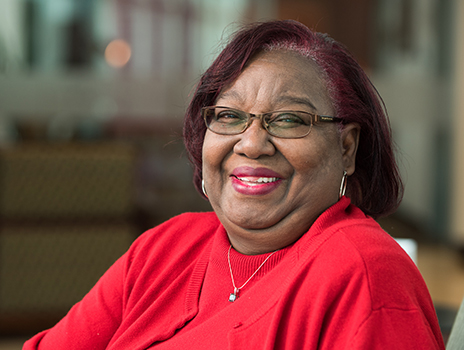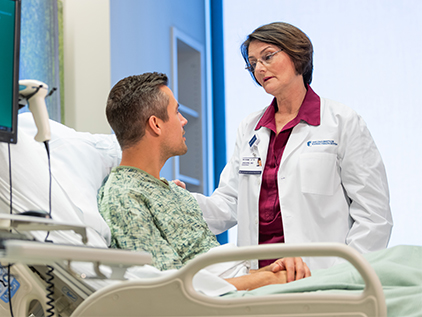A Heart Transplant Leads to Hope at the End of the Rainbow


October 15, 2018
As a geriatric nurse, Lola Brown was no stranger to caring for those with serious health conditions. But her own health issues took her by surprise.
"I was short of breath and tired. I thought I was just overweight and overworked," she says.
In 2014, Lola went to her doctor. She was tired and not sleeping well. Her doctor performed several heart tests and discovered her ejection fraction – a measure of how well the heart is working – was 10-15%. A normal ejection fraction is 55-65%.
"I didn't realize that my heart was sick," she says.
Brown was experiencing advanced heart failure, a condition that occurs when the heart doesn't pump blood to the body the way it should. She had a pacemaker implanted, and later, a pacemaker defibrillator. But neither treated the underlying cause of her condition.
Brown's doctor referred her to The University of Kansas Health System. There, she met with a cardiologist and cardiothoracic surgeon who conducted a complete series of tests.
"They tested every single thing except my ears," Lola says.
The doctors determined that Lola's heart failure was caused by a condition called non-ischemic cardiomyopathy – meaning she suffered from mechanical problems in the heart, rather than clogged arteries. Non-ischemic cardiomyopathy can be the result of many factors, such as long-standing high blood pressure, which Lola had a history of.
To survive, Lola would need a heart transplant. But her weight made her ineligible for transplant surgery. Instead, the surgeon placed a left ventricular assist device (LVAD) to keep her heart functioning while she lost weight.
"The LVAD kept her alive and prevented her from getting sicker," the cardiologist says. "It was a temporary solution that allowed her the option of transplant down the road."
With the LVAD keeping her heart failure symptoms under control, Lola wasted no time getting healthy. She cut out soda and sweetened tea, as well as her daily Danish pastry. She started drinking water and exercising and stopped eating after 7 p.m.
"I knew what I needed to do," Lola says. "I wanted to live, and I had an opportunity to get well, so I had to do it."
Within a few months, Lola had lost 30 pounds – enough to be re-evaluated for a heart transplant. Now at a healthy weight, she was cleared for surgery and put on the transplant waiting list.
While eating dinner with her family in March 2017, Lola received the call that changed her life: A new heart was available.
"I was stunned. I didn't know what to do or think. I just sat there," she says. "And then my daughter said, 'Get your butt up and go to the hospital!'"
Lola was already packed and ready to go. Together with her son and daughter, she drove from Junction City, Kansas, to The University of Kansas Health System in Kansas City. On the way, she saw 5 rainbows.
"I saw the rainbows and I thought, 'That means it's OK. That means I'm supposed to do this.'" Lola says, "I wasn't scared. I had faith in the doctors."
The surgeon performed Lola's 6-hour heart transplant procedure. The surgery was successful, and Lola was up and moving in a day or 2. Within 17 days, she was released from the hospital. In 6 weeks, she started cardiac rehabilitation.
"Lola is highly motivated and extremely willing to do whatever it takes to do well," the cardiologist says. "She deserves a lot of credit for her success."
Today Lola feels like herself again. She keeps busy with her 7 children, 29 grandchildren and 11 great grandchildren (with 1 more on the way). As the matriarch and chef of the family, she frequently hosts family gatherings complete with Swedish meatballs, Cornish hens, macaroni and cheese and sweet potato pie. She continues to receive care at The University of Kansas Health System and is grateful to her cardiology team.
"I can't say anything that wasn't pleasing about my experience," she says. "Everyone treated us like family – with the utmost respect. I feel like a celebrity when I go there. It was just perfect."
Lola still doesn't know the details about the donor who gave her a lifesaving gift, but she says her donor is never far from her thoughts. Today, Lola lives her life in a way that pays tribute to her donor – making healthy food choices, exercising, avoiding stress and following her doctor's recommendations.
"That was a great sacrifice," Lola says. "I've lost some of my natural children. I know the pain they [the donor family] must have felt. To make a sacrifice like that, I have to honor them. I have to do my best."
